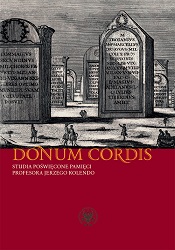Komendantura rzymskiego legionu w Novae. Od odsłoniętych ruin do pełnowymiarowej wizualizacji w terenie
Command headquarters of the Roman legion in Novae:
From uncovering the ruins to a full-size reconstruction in situ
Author(s): Tadeusz Sarnowski
Subject(s): Archaeology
Published by: Wydawnictwa Uniwersytetu Warszawskiego
Keywords: Jerzy Kolendo; archaeology; Poland; Europe; University of Warsaw; Polish Academy of Sciences
Summary/Abstract: This article is a tribute to the memory of Professor Jerzy Kolendo who through his inquisitive publications ofthe inscriptions from statue bases and altars has brought us much closer to understanding the religious aspectsof the functioning of the architectural complex of the legionary command headquarters (principia) in Novae. Theprincipia complex, studied with some intermissions between 1971 and 2010, at the end of the 1st century and in the2nd century initially consisted of four main components, that is, a monumental gate (groma), a courtyard (forummilitare) with porticos, a basilica (basilica principiorum) and a rear line of administrative rooms and clubs (scholae)with a temple of standards (aedes principiorum). The article mainly presents the construction elements uncoveredduring the last several excavation campaigns. These are: (administrative?) rooms added in the 3rd century to thesouth of the back wall of the original principia, including a two-column portal opposite corridor Dz, stairs leadingfrom the back part of the camp (retentura) to corridors Dw and Dz, the interior arrangement of rooms Ez3,Bw and Cw, a courtyard with a big area covered with large stone slabs in the centre, probably set apart for altarsand statues, the eastern side entrance to the building. These and the other elements of the building uncoveredearlier have provided us with a fuller picture of the architecture of the complex which was suffi cient for a virtualreconstruction of its appearance. It was then used to make a full-size reconstruction in situ. Together withthe consolidated walls of the early-Byzantine episcopal complex situated directly to the west of the principia, itbecame the main element of the archaeological park which was opened in May 2014.
Book: Donum cordis. Studia poświęcone pamięci Profesora Jerzego Kolendo
- Page Range: 335-345
- Page Count: 10
- Publication Year: 2019
- Language: English, Polish, German
- Content File-PDF

